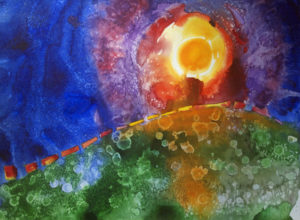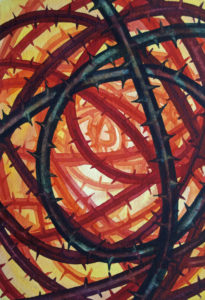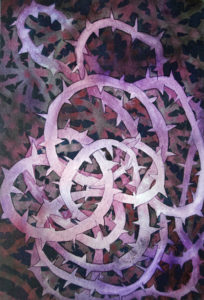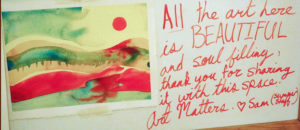I just finished a wonderful four-day watercolor intensive. It was preceded by a month-long once a week nature journaling class offered at the University of Wisconsin Arboretum. Both were wonderful experiences for me as the guide and facilitator. I argue that its always better to learn from someone who loves what they are teaching, especially watercolor. That is what the participants in my workshops and classes get.
Watercolor: The Hardest Medium?
Watercolor is often called the ‘hardest painting medium.’ While it is not true there are reasons for its reputation as the hardest painting medium. As someone who specializes in watercolor I have found that my students’ experiences with the medium, like so many other subjects, have been highly influenced by their past instructors. It is not unusual for new watercolor students to find themselves in a class with instructors who are very rigid in their approach (“Just paint like I do”), or who actually dislike the medium they are teaching.
On the college level it is not unusual to have an instructor who was forced into teaching watercolor as a part of their teaching load, when they were hired to teach oils or acrylics. Sometimes they even hate the medium because they do not entirely understand it themselves. It is not uncommon to think watercolor is easy because it is safe enough for children to use. The oil/acrylic painters are used to working with opaque paints and watercolor is something quite apart from that when used in a way that exploits their best features.
From my perspective as an oil and acrylic painter who converted thirty plus years ago, watercolor is less of a painting medium and more of a drawing medium (drawing with water and color). Oils and acrylics are both opaque mediums with which you first paint your local color and then bring your lighter colors and volume in AFTER you have the darker colors. Watercolor is exactly the opposite.
In watercolor you save the white of the page to create your light areas. As in drawing, you create a sense of volume by leaving the white of the paper to create light as you render the dark areas with your chosen medium. In watercolor your clean water is your ‘white.’ Because watercolor is a transparent medium, light waves go through the paint and bounce off the white of the paper underneath, causing it to glow like glass.
Hence, those who learn opaque painting techniques first may very well find watercolor to be the hardest medium because it is the opposite of everything they were ever taught. The person new to art, who may have done some drawing but has never painted in opaque mediums, will have an advantage because there is nothing to unlearn.
A Teaching Artist
At one point during my interactions with one of my workshop participants I found myself saying ‘I teach these classes and workshops because they make me a better artist. In order to teach a medium you have to figure out what you are doing that works so you can explain it.” That made me pause, because there is a myth out there, especially in graduate schools, that ‘those who can do, those who can’t, teach.’ This is wrong, and belittles teachers.
You cannot teach something well that you do not understand yourself. Also, when teaching your are reminded of what you know. You can find yourself getting so excited by what your students have discovered for the first time that you (I) cannot wait to get home and get back in the studio and re-explore some quality of the medium you have not played with for awhile! So thanks to all by students over the last month who took me on a journey of fun, experimentation, and discovery!
Upcoming Workshops:
I have two more 4-day Watercolor Intensives coming up this summer. One in Plain, Wisconsin in July, and another one in Madison in September. I teach them as two separate two-day workshops that can be taken alone or together (Workshop 1: Watercolor a Fresh Start. Workshop 2: Advancing Your Watercolors). Both of the workshops can be repeated.
It is also not unusual for someone to take the ‘Watercolor a Fresh Start’ which gives a refresher on all the basics, and go off and practice for a while, and then take ‘Advancing Your Watercolors‘ a few months later, or decide to re-take the Fresh Start again to get a stronger handle on the range of possibility of working with watercolors on paper. (If both workshops are taken within a 12 month period the 4-day discount still applies. Ask me about how to do it if its something you would like to do.)
September I am also planning to teach a three-day workshop on Painting Watercolor on Canvas. I have been exploring this method in recent years and decided to share what I have learned. The workshop will be taught in the Commonwealth Gallery in Madison, where I will also have a small exhibit of my own watercolors on canvas at the same time.
Finally, I will be offering my 3-day, 5-night Re-Vision Mixed Media Art & Creativity Intensive again at Björklunden in Door County in October. (This one is almost full so contact me soon if you are interested).
Contact me if you have questions about any of the workshops or go to my Creativity Lessons website where I post upcoming classes and how to work with me as a creativity coach or to consultant on all things art and career. As I said, I enjoy working with others because it reminds me of things I know that I may need to be reminded of in order to move my own art or career forward. So, ‘thank you’ clients and student!





One comment
Helen, I LOVE reading your blog posts about teaching, and looking at your amazing work. It has never ceased to amaze me!
I have been working with Amy Walsh as an art coach. I mean, SHE is coaching ME – on visibility. Never my forte.
xoxoxo, Marilyn
Your email is used for verification purposes only, it will never be shared. By submitting a comment you grant Helen R. Klebesadel a perpetual license to reproduce your words and name/web site in attribution. Inappropriate and irrelevant comments will be removed at an admin’s discretion.